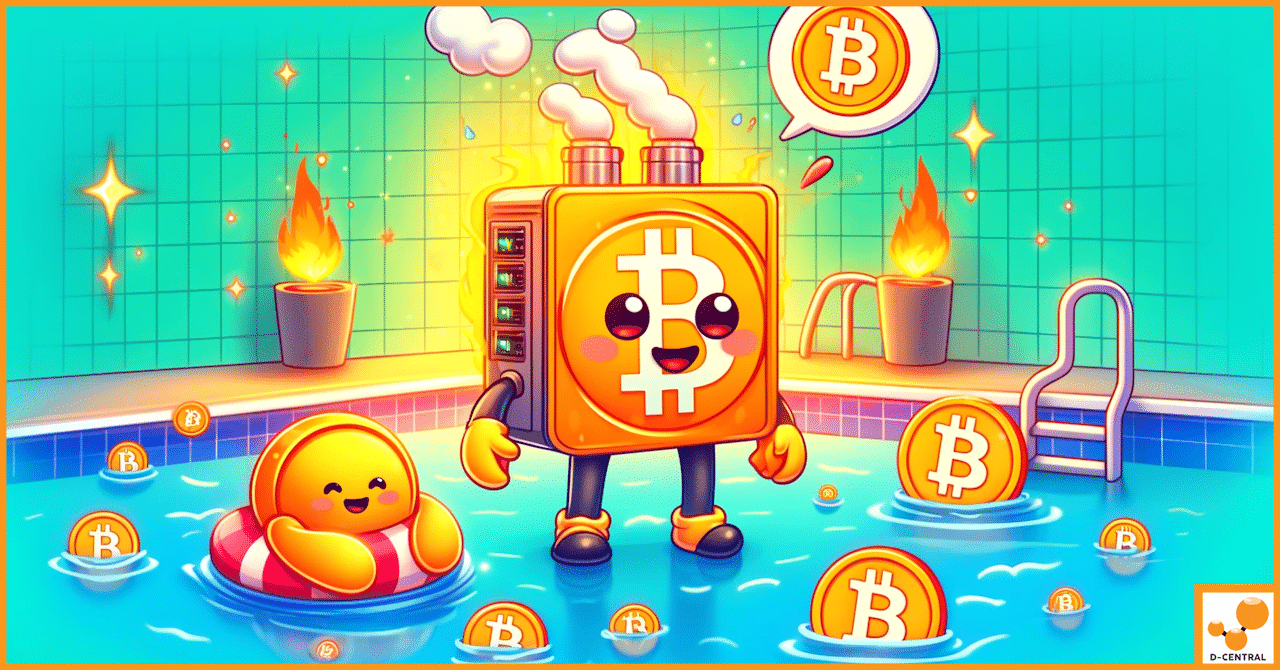
Why Small-Scale Bitcoin Mining & Hosting Thrive Against Industry Giants
The Bitcoin mining industry has undergone a remarkable transformation since its inception. In the early days, mining was a frontier
4479 Desserte Nord Autoroute 440, Laval, QC H7P 6E2

Bitcoin mining, a critical process for the cryptocurrency network, involves solving complex mathematical puzzles to verify transactions and secure the blockchain. This operation requires powerful computers known as ASICs (Application-Specific Integrated Circuits), which, due to their intensive computational demands, generate a significant amount of heat. Traditionally, this heat has been regarded as a byproduct, with most facilities expelling it to maintain operational stability and protect equipment.
However, a growing trend sees this excess heat as a valuable resource, particularly for heating applications. One innovative use is in heating indoor swimming pools, a substantial energy consumer in recreational and residential settings. By redirecting the heat generated from Bitcoin mining to pool water, facility owners can significantly reduce their heating costs and enhance energy efficiency.
This approach not only offers a method to cut down on operational expenses but also aligns with environmental sustainability goals. It utilizes a byproduct that would otherwise contribute to heat pollution or require additional energy to dissipate. Therefore, using Bitcoin mining’s excess heat for swimming pools presents a compelling case for cost reduction while promoting ecological responsibility.
Bitcoin mining is the backbone of the Bitcoin network, providing both transaction validation and network security. The process involves solving complex cryptographic puzzles that require significant computational power. Miners use specialized hardware to compete against each other to solve these puzzles first and earn Bitcoin as a reward. The intense computational effort needed to run these mining operations causes the hardware, especially the CPU and GPU, to heat up significantly.
Types of Equipment Used in Bitcoin Mining
The primary equipment used in Bitcoin mining includes ASICs (Application-Specific Integrated Circuits), GPUs (Graphics Processing Units), and less commonly, CPUs (Central Processing Units). ASICs are particularly favored in the mining industry due to their efficiency and speed. These devices are designed specifically for mining cryptocurrencies and are capable of producing a tremendous amount of computational power. However, the flip side of this power is the substantial amount of heat they generate. For instance, a typical ASIC can operate at a very high temperature, often needing extensive cooling solutions to prevent overheating.
Heat Output Characteristics
The heat output of mining equipment is directly related to their energy consumption. High-performance ASICs consume a lot of electricity, which almost entirely converts to heat during operations. For example, a single ASIC miner might use the same amount of power as half a household in the United States, turning all that energy into heat which, if not properly managed, can reduce the efficiency of the machines and even damage them.
Traditional Views and New Perspectives on Mining Heat
Traditionally, the heat generated from Bitcoin mining has been viewed as a cumbersome byproduct, with mining operations spending considerable resources on cooling systems to dispose of the heat. Cooling technologies not only add to operational costs but also impact the environment due to increased energy consumption. However, there is a growing recognition of this waste heat as a valuable resource. Innovative solutions are now being explored to harness this byproduct for practical uses such as heating buildings, industrial spaces, and more recently, indoor swimming pools. This shift not only helps in making Bitcoin mining more environmentally friendly but also improves the overall efficiency of thermal management in mining operations.
By re-evaluating the role of waste heat, the industry is moving towards more sustainable practices, where every output is utilized to its fullest potential, paving the way for more integrated and energy-efficient mining solutions.
Various innovative projects have demonstrated the practical reuse of heat generated from Bitcoin mining, turning a byproduct into a beneficial resource. Notably, in North Vancouver, a project has successfully implemented a system that diverts heat from Bitcoin mining to enhance municipal heating solutions. This initiative not only reduces the carbon footprint but also provides a blueprint for other cities to follow. Similarly, several bathhouses have adopted this technology to maintain warm, inviting pool temperatures, enhancing customer comfort while reducing energy costs significantly.
Technical Setups for Heat Transfer
One of the key technologies enabling the effective transfer of heat from Bitcoin mining to applications like swimming pools is immersion cooling. This system involves submerging Bitcoin mining rigs in a thermally conductive but electrically insulating fluid. The heat generated by the miners is directly transferred to the fluid, efficiently captured, and then redirected, for example, to heat swimming pools. Facilities such as Data Center Dynamics have documented the use of such setups to illustrate how immersion cooling not only aids in heat reuse but also enhances the operational efficiency and lifespan of mining equipment by keeping it cool.
Broader Industrial Applications
The concept of repurposing Bitcoin mining heat extends beyond swimming pools and residential heating. For instance, the distillery industry has found innovative ways to utilize this excess heat. Projects like those undertaken by Compass Mining Inc. have shown that heat from Bitcoin mining can assist in the distillation process, proving that this energy can be harnessed for a variety of industrial applications. This not only optimizes energy use but also opens up new avenues for industries looking to enhance their sustainability practices.
These examples highlight a growing trend towards using Bitcoin mining’s byproduct heat in ways that contribute positively to energy efficiency and sustainability across different sectors. As these practices gain traction, they pave the way for more widespread adoption of heat reuse strategies in various industrial and commercial settings.
Utilizing the heat generated from Bitcoin mining for heating indoor swimming pools presents substantial cost savings over traditional heating methods. Traditional pool heating systems, such as gas boilers or electric heaters, are often costly due to high energy consumption rates. In contrast, repurposing the heat from Bitcoin miners effectively uses a byproduct that would otherwise require energy to dissipate. This transition can reduce the operational costs of heating swimming pools by a significant margin, as the primary energy consumption shifts from heating to mining, which simultaneously serves another productive purpose.
Breakdown of Potential Reductions in Energy Bills and Increased Efficiency
The exact savings on energy bills can vary based on several factors, including the scale of the mining operation and the size of the pool. However, initial case studies and reports suggest that facilities using Bitcoin miner heat can expect a reduction in heating costs of up to 50-60%. This is primarily due to the high efficiency of heat transfer systems like immersion cooling, which directly captures and redirects nearly all the heat generated by the miners without significant loss. The efficiency of these systems not only cuts down on direct heating costs but also reduces the wear and tear on mining equipment, further decreasing long-term operational expenses.
Potential Revenue from Bitcoin Mining
In addition to cost savings on heating, Bitcoin mining itself offers a potential revenue stream. While the profitability of Bitcoin mining can fluctuate based on Bitcoin’s market price and the cost of electricity, the continuous operation required for heating provides a steady opportunity to generate Bitcoin. This setup transforms an otherwise substantial cost center (pool heating) into a dual-benefit system that both heats and potentially profits. For instance, even if the price of Bitcoin is low, the reduced cost of heating can justify the mining operation, while any rise in Bitcoin prices can significantly enhance the overall profitability of the venture.
By integrating these systems, facility operators not only reduce their carbon footprint and operational costs but also align with broader trends in energy efficiency and sustainability, adding an attractive layer of financial and environmental incentive. This holistic approach to energy management exemplifies the innovative possibilities at the intersection of technology and sustainability, making it an appealing option for forward-thinking businesses and communities.
Step-by-Step Guide
Necessary Equipment
Common Challenges and Solutions
By carefully planning and addressing these challenges, you can effectively set up a system that not only heats your indoor swimming pool using the waste heat from Bitcoin miners but also contributes to a more sustainable and cost-efficient operation.
Potential Hurdles in Adopting Bitcoin Mining Heat for Pool Heating
Scalability of the Systems
Regulatory and Safety Issues
Long-Term Viability and Market Fluctuations
By thoroughly understanding these challenges and considerations, pool owners can better prepare for the complexities involved in integrating Bitcoin mining with pool heating systems. Proper planning, adherence to regulations, and ongoing maintenance are crucial for the successful implementation and operation of such innovative systems.
The innovative practice of utilizing Bitcoin mining heat for heating indoor swimming pools offers a myriad of benefits that extend beyond mere energy efficiency. This approach not only capitalizes on the otherwise wasted byproduct of Bitcoin mining—heat—but also provides a sustainable and cost-effective solution for pool heating. By harnessing this excess heat, pool owners can significantly reduce their energy expenses while contributing to environmental sustainability through decreased reliance on conventional heating methods.
The potential of this technology is vast, presenting opportunities for synergy between the Bitcoin mining sector and the pool management industry. These partnerships can lead to enhanced energy utilization, opening new avenues for both industries to thrive in an eco-friendly and economically viable manner. As such, stakeholders from both fields are encouraged to explore collaborative projects that could set a precedent for future energy solutions.
For those interested in exploring the possibilities of integrating Bitcoin mining heat into pool heating systems, consulting with experts in the field is crucial. Specialists can provide insights into the technical implementation, cost-benefit analysis, and potential hurdles, ensuring that each project is tailored to meet specific needs and circumstances.
To learn more about this innovative heating solution or to discuss potential projects, interested parties are encouraged to reach out to industry consultants and professionals. By taking the initiative to evaluate and potentially implement such systems, pool owners and miners alike can contribute to a more sustainable and efficient future.
For further inquiries or to schedule a consultation, stakeholders are encouraged to contact relevant experts and organizations that specialize in energy reuse solutions in the Bitcoin mining and pool management sectors. This step towards innovative energy solutions not only promotes sustainability but also paves the way for operational efficiencies and cost savings in multiple industries.
What is the main benefit of using Bitcoin mining’s excess heat for heating indoor swimming pools?
The main benefit is the significant reduction in heating costs and enhanced energy efficiency for pools, which can also contribute positively to environmental sustainability by utilizing heat that would otherwise be wasted.
How does Bitcoin mining generate heat?
Bitcoin mining involves solving complex computational puzzles, requiring powerful computers like ASICs, which generate a substantial amount of heat due to their high energy consumption.
What types of equipment are primarily used in Bitcoin mining?
The primary equipment includes ASICs (Application-Specific Integrated Circuits), which are favored for their efficiency and computational power in mining cryptocurrencies.
Can the heat from Bitcoin mining really be repurposed efficiently?
Yes, through innovative setups like immersion cooling systems, the heat generated by Bitcoin miners can be captured efficiently and transferred to heat swimming pools, among other applications.
What are some challenges in utilizing Bitcoin mining heat for pool heating?
Challenges include the initial setup costs, maintenance requirements, scalability of the system, compliance with local regulations and safety standards, economic viability, and potential technological obsolescence.
What steps are involved in implementing this heating method?
Implementing this method involves assessing heat output and pool heating requirements, choosing efficient mining hardware, installing immersion cooling and heat exchangers, setting up piping, implementing control systems, and regular monitoring and optimization.
What are the potential economic benefits of this system?
Potential benefits include substantial savings on traditional heating costs and the possibility of generating additional revenue from Bitcoin mining, making the operation more cost-effective and potentially profitable.
What should pool owners consider before adopting this heating solution?
Pool owners should consider the economic and environmental benefits, the technical feasibility of integrating mining heat with their pool’s heating system, scalability, regulatory compliance, and the long-term sustainability of the project.
DISCLAIMER: D-Central Technologies and its associated content, including this blog, do not serve as financial advisors or official investment advisors. The insights and opinions shared here or by any guests featured in our content are provided purely for informational and educational purposes. Such communications should not be interpreted as financial, investment, legal, tax, or any form of specific advice. We are committed to advancing the knowledge and understanding of Bitcoin and its potential impact on society. However, we urge our community to proceed with caution and informed judgment in all related endeavors.
Related Posts

The Bitcoin mining industry has undergone a remarkable transformation since its inception. In the early days, mining was a frontier

Bitcoin, since its inception in 2009, has revolutionized the concept of currency and paved the way for a plethora of

As we embark on this journey to explore the Bitcoin halving cycle, it is essential to understand the fundamentals of